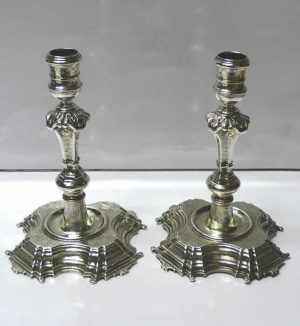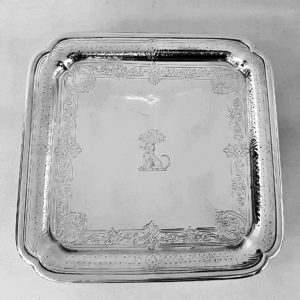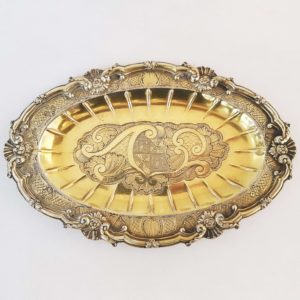Charles Kandler
Charles Kandler (Carl Rudolph Kändler) b.1695, a German from Saxony. Charles was mentioned in 1710 as apprenticed to goldsmith Jacob Irminger in Dresden. He arrived in London in 1727 and entered his first mark (New Standard and Sterling) that same year in partnership with James Murray. Murray died within a few months and Kandler registered new marks – New Standard (KA with a mitre above) and Sterling (CK with a pellet or mullet below in a shaped shield). He also used an unregistered mark (CK with a mitre above). Kandler’s early work shows a unique style, decidedly German in form. From 1730 he worked for the goldsmith and banker Henry Jernagan (Jerningham) in Russell Street, Covent Garden.
The identity of this highly important maker was a mystery until recent research showed him to be the elder brother of Johann Joachim Kandler, the prized porcelain modeller at the Meissen factory, with whom he shared many similarities of style.
Charles returned to Germany, probably because his father was not well. His younger brother Charles Friedrich Kändler (1712–1778) took over the business in London in September 1735 with a fresh set of sterling and new standard marks. A subsequent mark was entered in 1739.
Charles Kandler left a legend of outstanding works amongst which are the great wine cooler in the Hermitage Museum, St Petersburg and the remarkable kettle in the Victoria and Albert Museum, London.
Ref: Thomas Joski (6th great grandnephew) and https://de.wikipedia.org/wiki/Carl_Rudolph_K%C3%A4ndler
Charles Kandler
Charles Kandler (Carl Rudolph Kändler) b.1695, a German from Saxony. Charles was mentioned in 1710 as apprenticed to goldsmith Jacob Irminger in Dresden. He arrived in London in 1727 and entered his first mark (New Standard and Sterling) that same year in partnership with James Murray. Murray died within a few months and Kandler registered new marks – New Standard (KA with a mitre above) and Sterling (CK with a pellet or mullet below in a shaped shield). He also used an unregistered mark (CK with a mitre above). Kandler’s early work shows a unique style, decidedly German in form. From 1730 he worked for the goldsmith and banker Henry Jernagan (Jerningham) in Russell Street, Covent Garden.
The identity of this highly important maker was a mystery until recent research showed him to be the elder brother of Johann Joachim Kandler, the prized porcelain modeller at the Meissen factory, with whom he shared many similarities of style.
Charles returned to Germany, probably because his father was not well. His younger brother Charles Friedrich Kändler (1712–1778) took over the business in London in September 1735 with a fresh set of sterling and new standard marks. A subsequent mark was entered in 1739.
Charles Kandler left a legend of outstanding works amongst which are the great wine cooler in the Hermitage Museum, St Petersburg and the remarkable kettle in the Victoria and Albert Museum, London.
Ref: Thomas Joski (6th great grandnephew) and https://de.wikipedia.org/wiki/Carl_Rudolph_K%C3%A4ndler
-


1737
Charles Kandler
6318 George II Antique Silver Candlesticks by Charles Kandler
Sold
An important pair of early English antique silver candlesticks by the sought after maker Charles Kandler. Very fine quality and made of heavy gauge cast silver. In the French taste, each with a knopped baluster stem on spreading circular base with sunken well and shaped outside border. These stunning candlesticks are beautifully chased all over and each bears an armorial crest within the sunken well. Weight 1459 grams, 46.9 troy ounces. Height 22cm. Base diagonal measurement 16.25cm. London 1737. Maker Charles Kandler.
-


1759
Charles Kandler
10106 George II Antique Silver Salver
Sold
A fine early English silver salver by the sought after maker Charles Frederick Kandler. Of square form, and raised on tall scrolling feet, this rare salver is hand engraved with an expansive outer border of scroll motifs, the centre with the Tatton crest of a greyhound tied to a tree. Super heavy quality and feels very good in the hand. Perfect to stand a bottle or wine glass on top. Weight 408 grams, 13.1 troy ounces. Width 16cm. Height 4cm. London 1759. Maker Charles Frederick Kandler. Sterling silver.
-


1731
Charles Kandler
10207 George II Antique Silver Spoon Tray
Sold
An outstanding piece of workmanship by this rare and sought after maker. A small gilt silver tray; the cast, scalloped border with shell motifs, the outer border and centre with fine hand engraved decoration. The armorial is for the Gilbert family with the motto “Pro Christo et Patria” below. Weight 225 grams, 7.2 troy ounces. Length 17.6cm. Width 11.5cm. London 1731. Maker Charles Kandler. Sterling silver.